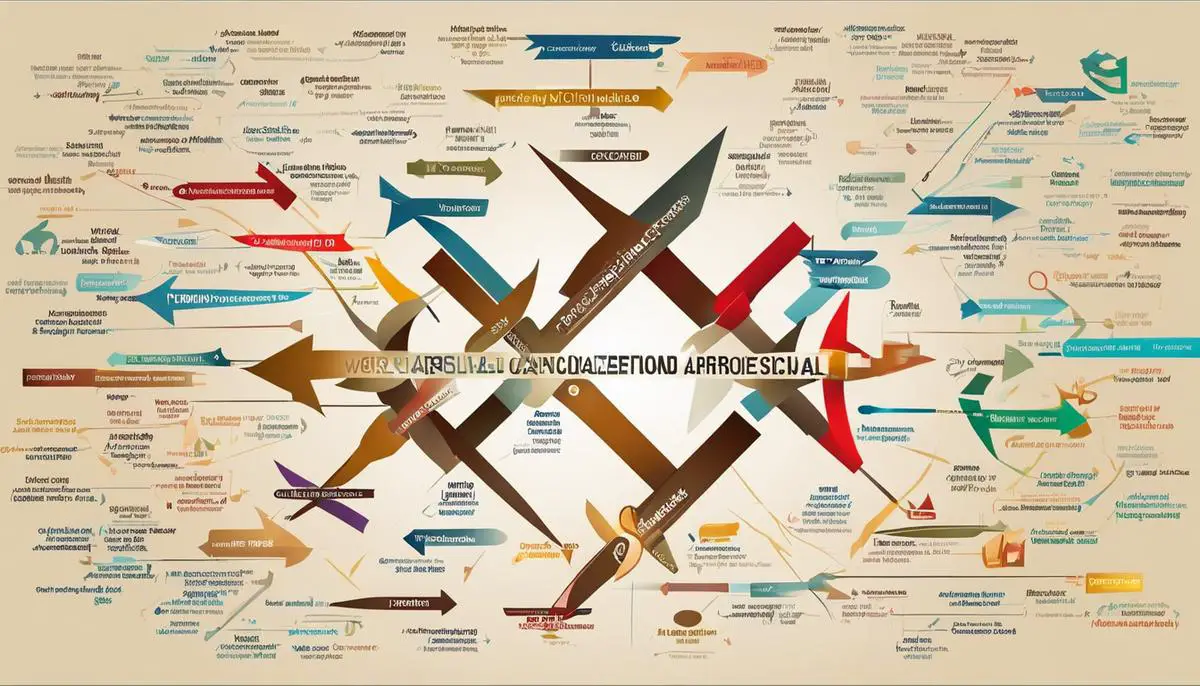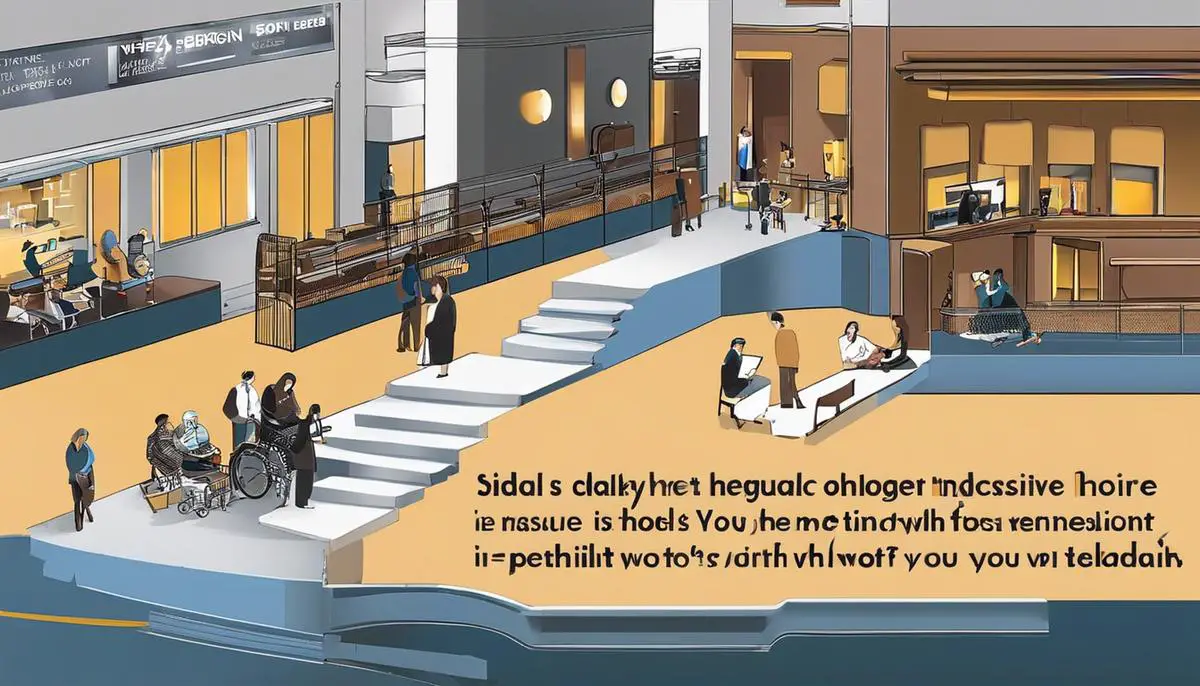Mastering Modals in British English
The rich tapestry of English language holds several threads of grammar and syntax, where modals represent a distinct, vibrant strand. As a prelude to a deeper academic discussion, they serve as auxiliary verbs that lend nuances to the principal verb they govern, expressing notions of necessity, possibility, permission, and ability. This investigation embarks on a journey through the heart of English modals, touching upon the ten primary ones: ‘can’, ‘could’, ‘may’, ‘might’, ‘shall’, ‘should’, ‘will’, ‘would’, ‘must’, and ‘ought to’. Venturing forth into its different contexts of ability, possibility, obligation, and permission, to its lesser-known landscapes of passive voice, it is anticipated that this exploration will unfold the abundant intricacies of modals and their transformative effects on meaning and emphasis.
Identifying Modals
Title:
The Recognition and Classification of Modals: A Comprehensive ExaminationWithin the vast fields of linguistics and grammar study, the role and understanding of modals invariably stand as both an intrigue and a challenge. These auxiliary verbs shape the tone and mood of sentences, imparting varying degrees of necessity, possibility or ability. In the context of English language, modals are an integral part of communication, being capable of transforming statements into questions, expressing polite requests or exuding uncertainty. This article aims to elucidate upon how modals are recognised and subsequently classified, a cornerstone of understanding when exploring language mastery.
In the most demonstrative sense, modals can be identified by their distinctive characteristics. Fundamentally, they are verbs that never change their form irrespective of the tense or number. They stand out in a sentence structure as they precede infinitive verbs without a ‘to’, and typically cannot function in the absence of a main verb. Examples of modals in English language are can, could, may, might, will, would, shall, should, must and ought to.
Delving into the heart of their classification, modals can be broadly categorized by their nuanced meanings and construct within a sentence. From the dimension of likelihood or ability, we find ‘can’ and ‘could’. ‘Can’ denotes capability or allows permissions, whereas ‘could’ introduces the possibility or permission in a polite or less definitive manner. ‘May’ and ‘might’ usually express the likelihood of an occurrence, with ‘might’ suggesting a lower degree of certainty.
‘Must’ invariably signifies an obligation or necessity, regardless of the context it is used in. ‘Shall’ and ‘will’ demarcate the realm of future events or intentions. Nevertheless, in common parlance, ‘will’ has outstripped ‘shall’ in most contexts, with the latter being largely employed in a more formal or legal context.
Furthermore, a focus on the auxiliary modals ‘should’ and ‘ought to’ reveals subtle aspects of suggestion, advisability, necessity, or moral obligation. It is pivotal to note that the subtle differences in meaning and usage of modals can vary based on the cultural and regional expressions of English.
Last but not least, we encounter semi-modals such as ‘need to’, ‘have to’ and ‘going to’, a group of verbs that function similarly to primary modals but follow the ordinary conjugation rules of other verbs.
Undeniably, the recognition and categorisation of modals is a vital step in comprehension and effective communication. Consequently, understanding these nuances enriches one’s linguistic versatility, whilst shedding light on the elegance and complexity of language structures. The science and art of modals fuse together to construct a harmonious symphony of expressions, enhancing the beauty and depth of linguistic communication. The study and appreciation of modals is thus a testament to the power and subtlety of language, a riveting journey through the multifaceted landscape of English grammar.

Modals of Ability
Modals, as the previous discussion deeply elaborated, are a fascinating aspect of language, enriched by cultural sensitivities, and nuances of meaning. Continuing ahead from our previous exposition, this section will dissect the relationship between modals and the expression of a person’s skill or capability. It may at first seem peculiar to relate these two concepts. However, as the argument progresses, one will understand that modals are indispensable tools for expressing proficiency and potential in a language.
The connection between modals and proficiency is often observed in the way they are used to show possibility or ability. The modals ‘can’, ‘could’, ‘may’, ‘might’, ‘should’, ‘would’, and ‘will,’ to name a few, all offer insight into capability or potentiality. The modal ‘can’ expresses an individual’s ability to perform a task or their permission to do so, but ‘may’ leans more towards the permission given or guessed upon potentialities.
Take for instance the phrase ‘”She can play the piano well”‘. Here, the modal ‘can’ is confidently affixed to the verb ‘play’, showing an established skill or proficiency. Contrastingly, if one were to say, ‘”He should be able to compete”‘, the modal ‘should’ implies an assumed competence or theoretical ability.
A closer examination of the same context may yield further intricate forms of expression. For instance, ‘”She could play the piano if she practises”‘, subtly places the ‘could’ in a hypothetical situation where the skill is possible, though not yet realised.
‘Auxiliary verbs are another interesting aspect as they often support the main verb in a sentence and refer to different points in time. Such expressions are more complicated and often intertwined with tense structures, conveying information about the timing of a proficiency or ability. It is important to note that the usage of modals in relations to abilities and skills is not always straightforward and can be laden with deeper conceptual subtleties.
It is vital to approach the study of modals with a significant amount of cultural cognisance. Culture plays an intricate role in shaping the nuanced meanings of modals. Take ‘can’ and ‘may’ as examples. While both can be used to request permission, ‘may’ is often considered more polite and formal, especially within western societies. However, in more informal or colloquial contexts, ‘can’ is often favoured, illustrating the role cultural dynamics play in modal usage and understanding.
To conclude, modals, due to their ambiguous and often culture-specific nature, provide a rich vein for language study. Tracing modal usage to express ability and skill offers a clear understanding of cultural nuances, complexities of perception, and the overall elegance of language structures. When we comprehend the versatile usage of modals, we appreciate the sophistication and the linguistic finesse they add to the comprehension and precision of our communication. As such, it is crucial to maintain acuity towards modals’ subtle variances to ensure effective and suitable usage in our discourse.

Modals of Possibility and Probability
Delving deeper into the intriguing dimension of modals in language study, attention must be drawn towards the illustrative nature of modals in denotation of probability and possibilities. An in-depth understanding of modals showcases their unique capability to encode speaker’s attitude towards likelihood and feasibility of an action, essentially communicating a rich tapestry of hypothetical worlds, desires, wishes, and uncertainties.
Modals, with their unparalleled multidimensionality, allow us to convey varying degrees of probability. For instance, in the English language, the modal ‘might’ suggests a lower probability than ‘may’, while ‘could’ is used to indicate a theoretical possibility as opposed to an existential reality. Similarly, ‘must’ connotes a strong probability, often based on concrete evidence or robust logical deduction, as opposed to ‘should’, which often delicately balances between advice and expectation with a touch of subjectivity involved.
For instance, consider the sentence “It may rain today.” Here, ‘may’ aptly expresses a speaker’s perception of the likelihood of the situation while also acknowledging the encapsulated uncertainty. This representation of the probability spectrum is distinctively possible due to the nuanced interplay of modals.
Expanding the frame to include semi-modals like ‘have to’ and ‘need to’, an individual’s subjective obligation or lack thereof concerning an event becomes apparent and definite. In this context, they reflect the speaker’s personal assessment of a situation’s prerequisites and the associated desirability.
Furthermore, modals perform an essential function of depicting hypothetical situations. The conditional modals, namely, ‘could’, ‘would’, and ‘might’, create hypothetical landscapes in conversation, enriching the dialogues with antithetical, unreal, or improbable situations. When studying expressions such as, “If I had more time, I could read more books”, one determines the rich potential of modals to venture away from reality and explore theoretical realms, defined by various nuances of probability and determination.
Noticeably, the auxiliary verb ‘will’ must be captured in this narrative, given its pivotal role in implying future possibilities. Analysis of the simple phrase ‘It will rain’ sheds light on the deterministic nature of ‘will’, creating a strong implication of a future event, thereby highlighting the broad spectrum of possibility represented by modals.
While understanding the functional layers of modals, cultural awareness is of paramount importance. Cultural and regional disparities significantly influence the usage of modals, thereby emphasizing the need for contextual aptitude. American English, for instance, frequently uses ‘might’ to express probability, while speakers of British English may use ‘may’ more frequently, mirroring the profound impact of cultural nuances on language structures.
Consequentially, it becomes evident that a thorough understanding of modals, their application and varying degrees of implications lead to a finer comprehension of language and its compelling complexities. Therefore, this intricate system of modals, with their ability to intricate probabilities and hypothetical situations, becomes an integral cornerstone of linguistics, elevating communication beyond the mundane, to reach the pinnacles of thought, expression, and conjecture.

Modals of Obligation and Necessity
As we navigate deeper into the realm of modals, it is vital to unravel their role in depicting duties and necessities. In this context, the focus shifts to modals such as ‘have to’, ‘must’, ‘should’, ‘ought to’, which all encompass the sphere of obligation, necessity, and duty.
From an analytical perspective, the modal ‘must’ carries the strongest degree of obligation, often employed to portray a personal, innate sense of duty. For instance, ‘One must respect cultural diversities’ implies an inner conviction transcending external requirements. Following this, ‘have to’ is typically used to indicate external obligations or regulations, as seen in phrases such as ‘students have to submit assignments by the deadline’, where the duty springs from external rules rather than personal belief.
Meanwhile, the modal ‘should’ conveys suggestions, recommendations or moral obligations; it is less forceful than ‘must’ or ‘have to’. For instance, ‘One should eat healthily’ implies a desirable action rather than an enforced rule. The modal ‘ought to’ holds similar connotations, although it is less commonly used in modern English, often replaced by ‘should’.
Interestingly, the use of modals to convey duty or obligation can be influenced by sociolinguistic factors. In some varieties of English, obligations and rules might be expressed using different modals or constructions altogether. Such disparities in modal usage exhibit the potent interrelation between language and society, portraying the capacity of language to resonate with socio-cultural nuances.
Relative to English, the auxiliary verbs ‘have to’ and ‘need to’ fall into the category of semi-modals. These portray objective obligations. Their use in negatives and interrogative sentences, however, signifies their deviation from a typical modal function, bearing unique characteristics that challenge standard modal definitions.
One must note that modals not only create broader semantic landscapes but also allow for grammatical rarity; consider the example of the future-oriented auxiliary ‘will’, which despite being a modal, allows tense marking, a feature avoided by other modals.
In grasping the complexity of modals, comprehension of a context is paramount. The precise interpretation of a modal’s meaning is discerned from the broader linguistic environment. Consider the utterance, ‘I have to go’. Although ‘have to’ typically implies obligation, in a different scenario, it might represent a need generated by physical discomfort, rather than obligation.
Modals, therefore, leave an indelible impact on language structures and communication skills. Their mastery not only improves linguistic precision but also unveils the subtlest shifts in meaning, enriching our understanding of the endless possibilities of human communication. In the grand theatre of language, modals indeed play a leading role, proving that linguistics is not just about the accuracy of grammar but the exploration of human expression, societal norms, and cultural nuances.

Modals of Permission and Request
With meticulous examination of modals, it becomes apparent that these linguistic tools form an advanced framework for conveying permissions and making requests. As a linguistic phenomenon, modals create pathways to unveil politeness and respect while facilitating social interactions. Integral to the functional dimension of language, they serve to establish norms and convey intentions, thereby highlighting a significant aspect of human communication.
To delve deeper into this perspective, let’s consider the modals ‘may’ and ‘can’. These modals are distinct tools for politeness strategy, effectively used in English-speaking societal bounds to make requests or grant permissions. The utterance “May I borrow your book?” exemplifies an enquiry wrapped in the subtle veil of politeness, denoting a request. Correspondingly, the response “Yes, you may,” marks the approval or permission. Menial as these everyday phrases might seem, they resonate a phenomenal linguistic exchange enabled and empowered by modals.
Contrastingly, the modal ‘can’ imparts a more direct, albeit less formal approach to a similar dialogue. “Can I borrow your book?” rings less ceremonious but performs an equivalent function as ‘may’. Indeed, ‘can’ and ‘may’, while used interchangeably in colloquial discourse, possess implicit nuances of formality and politeness.
Another critical phenomenon is the employment of negative modals to voice polite denials tactfully. For instance, consider the sentence, “I’m afraid I can’t lend you the book.” The negative ‘can’t’ serves a dual function, expressing inability while subtly disallowing the request, all without breaching the boundaries of politeness.
Alternately, semi-modals such as ‘would you mind’ or ‘could you please’ offer a refined approach to making requests. Illustrating this, gentlemen across ages have said, “Would you mind if I take the last piece?” Such a request, meticulously woven around a semi-modal, differs starkly from a curt “I’m taking the last piece”, shedding light on the cultural significance of modals and semi-modals as tools of civility.
In comparing modals, consider the distinction between ‘must’ and ‘have to’. Both express obligation, yet ‘must’ bears an innate level of urgency or seriousness often associated with rules or laws. For example, “You must stop at a red light” signifies the rule’s obligatory nature. However, ‘have to’ projects a personal necessity or requirement. Therefore, “I have to complete my homework” manifests a self-implied need rather than a societal one.
Parsing modals like ‘should’ and ‘ought to’ also provides insights. Although interchangeable in conversational English, these modals subtly differ. ‘Should’ generally suggests advice or an opinion, while ‘ought to’ pertains to what is ethically right or expected, emanating a moral undertone.
In conclusion, understanding the versatility of modals lends a profound appreciation for the eloquence of language. Truly, modals – these seemingly innocuous words – carry paramount significance, whether granting permissions, making requests, voicing obligations or making requests in myriad social contexts. They reflect the remarkable capacity of language to navigate cultural norms with subtlety, signalling an indelible impression of human communicative sophistication and sociocultural nuances.

Modals in Passive Voice
Understanding Modals in Sentences Using Passive Voice
Passive voice is an intriguing component of English grammar. It is engaged to focus more on the action or the receiver of the act, than the actor. Verbs occur in passive voice sentences in two parts: a form of “be” as an auxiliary and the past participle of the main verb. The role of modals in such context becomes pivotal.
Modals in passive voice sentences modify the main verb, acting as auxiliary verbs. Auxiliary verbs, as a family member of modals, provide additional information regarding the intention or the mood of the verb. This ranges from depicting necessity, probability, permission, or capability. Passive voice, while shunning spotlight on the ‘doer’, underlines the action or the effect. It holds immense significance in the realm of academic, scientific, diplomatic, and legal language uses.
When modals ‘can’, ‘could’, ‘may’, ‘might’, ‘shall’, ‘should’, ‘will’, ‘would’, ‘must’ are used in the passive voice, they arrive before the “be” verb. For instance, a sentence like “The task can be done by tomorrow” expresses the potential of a task’s completion, yet, draws attention away from who will be performing the task.
The inclusion of modals in the domain of passive voice sentences opens up an array of expressions that heighten the impact of language. In every tone, be it asking permission as in “May I be excused?”, or speaking hypothetically as in “This problem could have been avoided.”, modals used with a passive verb forms supply a linguistic richness unlike any other morphosyntactic form.
Usage and comprehension of modals in passive voice sentences are contingent on mastering the essential characteristics of both modals and passive voice. This implies a thorough understanding of varied functions and meanings of modals – a topic extensively discussed in previous parts of this article, as well as the structure of passive voice sentences.
Adeptness in the use of modals in passive voice sentences equips communicators with a powerful tool. Whether articulating scientific hypotheses, discoursing on legal situations, or narrating a chain of events in a historical text, modals with passive voice can enhance comprehension and interpretation dramatically.
Understanding and application of modals in passive voice presupposes a keen awareness of their contributions to the linguistic repertoire. Their usage, beyond reflecting the speaker’s intent and attitudes, holds a mirror to one’s cultural and linguistic journey. The complexity and elegance of modals in passive voice sentences underscore the beauty, commodiousness, and sophistication of the English language. Hopefully, the intricacies of these word classes would continue to fascinate and stimulate language enthusiasts to delve deeper into the fascinating world of Language and Linguistics.

As we descend from this elevation of modal exploration, it becomes evident that these central cogwheels of the English language serve as a mechanism to effectively vary and manage the meaning and intensity of our declarations. The modulation of potency and temporality, the graduation of certainty and doubt, the necessity, and obligation denotations, and the politeness depicted through requests and permissions, all tumble under the expansive umbrella of modals. Moreover, their dynamic interaction with passive voice constructions affirms their tremendously versatile nature. Thus, the journey through the aria of modals fortifies their structural and semantic significance in the tapestry of the English language, illuminating their role as a quintessential tool for comprehensive communication.
Writio: AI-powered content writer creates top-notch articles for websites and blogs. This piece, crafted by Writio, showcases its exceptional writing prowess.

